PU foam adhesive, also known as Polyurethane Foam, is one of the most versatile thermal insulation materials. In fact, PU foam adhesive plays a crucial role in the construction industry and industrial projects in improving performance due to the sustainable properties it offers.


Today, PU foam adhesive is used for thermal and acoustic insulation as well as for sealing and filling, significantly enhancing the energy efficiency of buildings.
Energy loss through walls, roofs, and windows constitutes the largest energy waste in most buildings. Energy loss translates to increased operational costs and decreased comfort, not to mention the rise in carbon emissions.
Hitta is pleased to introduce Bostik’s PU foam adhesive, providing high-quality polyurethane foam adhesive for bonding panels in External Thermal Insulation Composite Systems (ETICS). ETICS, short for Exterior Thermal Insulation Composite Systems, refers to a system of thermal insulation applied externally or on the sides to enhance a building’s thermal performance.
The PU foam adhesive boasts the best thermal performance and bonding, certified with ETA004:2000.
Expanding beyond the mentioned applications, the polyurethane foam adhesive also comes in one and two-component variations.
The adhesive can be applied manually or with a specialized PU Foam spray gun. Depending on the type, the foam can expand up to 30 times its original volume after use and harden under the influence of moisture in the air and/or from construction materials.
Therefore, Bostik’s PU foam adhesive is highly versatile, durable, and extremely sustainable! In the next section, Hitta will delve into the technical characteristics, applications, and provide advice to help customers choose the most suitable PU foam adhesive!
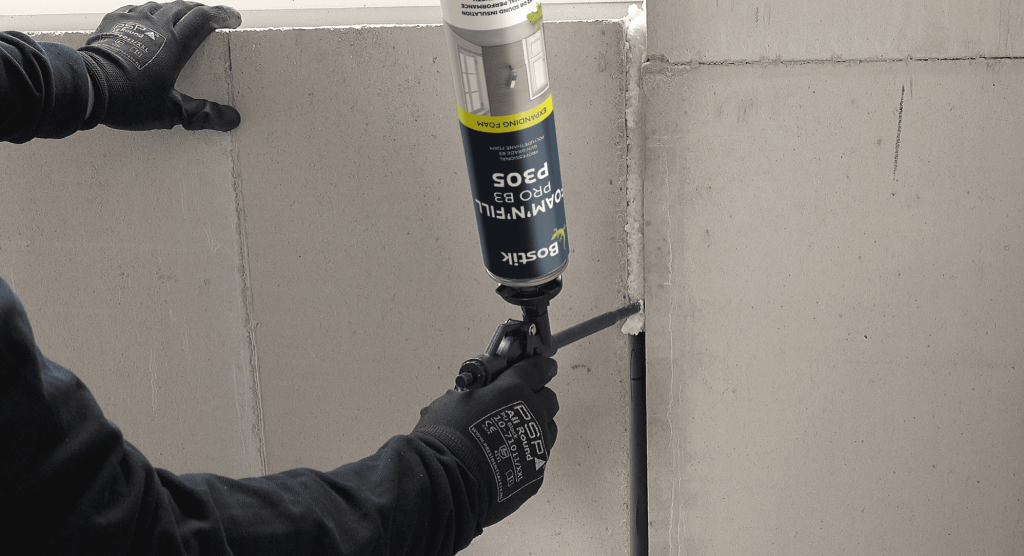
Certifications and standards
The new Bostik Polyurethane Foam filler product line complies with numerous renowned industry certification standards and regulations.
European fire resistance certifications EN 13501 & DIN 4102
The certifications refer to the ability to protect against fire hazards and assess the reaction to fire as well as the basic fire resistance when planning and constructing buildings.
The fire reaction of polyurethane foam used in the construction industry has been classified according to standards such as DIN 4102. The new fire reaction classification system for construction products according to EN 13501-1, established by the European Association, categorizes PU foam adhesives based on their fire behavior as fire resistant (B1), easily flammable (B2), and highly flammable (B3).
The passive fire protection certification EN 1366-4 is a European standard
The passive fire protection certification EN 1366-4 is a European standard. This certification pertains to passive fire protection products used in the construction of a building to limit the spread of fire, heat, and smoke, significantly enhancing fire safety.
By applying these products correctly, basic legal compartmentation requirements are met. These products contribute to the structural stability of a building and provide time for safe evacuation or building evacuation. Passive fire protection limits the spread of fire and smoke, thus preventing the transmission and propagation of fire between compartments.
Bostik’s polyurethane foam filler can be applied according to EN 1366-4 for linear joints. Products and systems tested according to EN 1366-4 are used to completely seal fire compartments where walls, frames, and floors meet. Most of these products and systems are designed to absorb movements within building components.
The ISO 10140 certification pertains to acoustic insulation and noise reduction
Noise pollution is a serious issue in our daily lives, especially with the increasing urbanization trend. A well-designed building not only conserves energy but also shields against noise pollution from the external environment.
Polyurethane (PU) foam fillers can significantly contribute to reducing external noise pollution. The cellular structure of the foam is engineered to absorb sound propagation.
Bostik’s PU foam fillers have been tested for noise reduction capabilities by IFT Rozenheim, Germany (a company supporting standards in the window, facade, and door industry).
The ETA 004:2000 standard
This standard sets out requirements for the performance of External Thermal Insulation Composite Systems (ETICS) to be used as external thermal insulation materials for building walls.
GEV-EMICODE EC1 Plus environmental safety certification
The GEV-EMICODE EC1 Plus environmental safety certification is part of the EMICODE® classification system, which labels products as eco-friendly. Products within the scope of installation materials, adhesives, and building materials must adhere to a rigorous certification process, which includes testing the amount of volatile organic compounds (VOCs) emitted.
A+ Certification
‘A+’ is the mandatory VOC emission label in France for construction products installed indoors, based on emission testing. This regulation requires that any insured product brought to the market must be labeled with emission classes based on their emissions after 28 days, as tested with ISO 16000 and calculated for the European reference room, corresponding to EMICODE, GUT, and Blue Angel standards.
BREEAM Certification
BREEAM is the world’s leading sustainability assessment method for masterplanning projects, infrastructure, and buildings.
Certifications & standards compliance in Vietnam
All products are compliant with standards and regulations in Vietnam: Quatest 3, FMVSS212, etc.
Advice on choosing and purchasing PU foam
In order to choose the right product, you need to consider the following:
Polyurethane Foam

Polyurethane foam adhesive, or PU foam adhesive, is a mixture of polyol and isocyanate components in a single container, with the addition of a propellant. The prepolymer with isocyanate functionality is formed inside the container before spraying. The curing process occurs through reaction with moisture from the atmosphere and the substrate. This reaction results in cross-linking and volume expansion.
Advantages of PU foam adhesive
- Good adhesion to most common substrates.
- Thermal conductivity (value of ʎ ± 0.030 – 0.035 W/m.K).
- Noise reduction.
- Vapor permeability.
- Low density = large volume from a single container (convenient, cost-effective, and eco-friendly).
- Filling and sealing gaps in all shapes.
- Easy to use.
Types of Polyurethane Foam Adhesive:
For Bostik PU foam adhesive, there are various types categorized based on application and technical specifications. These include:
- Tube-type (handheld) and gun-type adhesives.
- Fire-resistant, heat-resistant, and flame-resistant types according to DIN 4102 standard.
- One-component and two-component PU foam adhesives.
- Expanding foam adhesives.
- Specialty foam adhesives.
Some points to note about PU Foam Adhesive:
- Formulation may contain isocyanate.
- Uncontrolled expansion.
- Temperature sensitivity during application.
- Pressurized container (dangerous at high temperatures, >50°C).
- Propellant is flammable.
- Susceptible to UV radiation.
- Restrictions on transportation in vehicles.
Consider whether to use handheld or foam gun PU adhesive
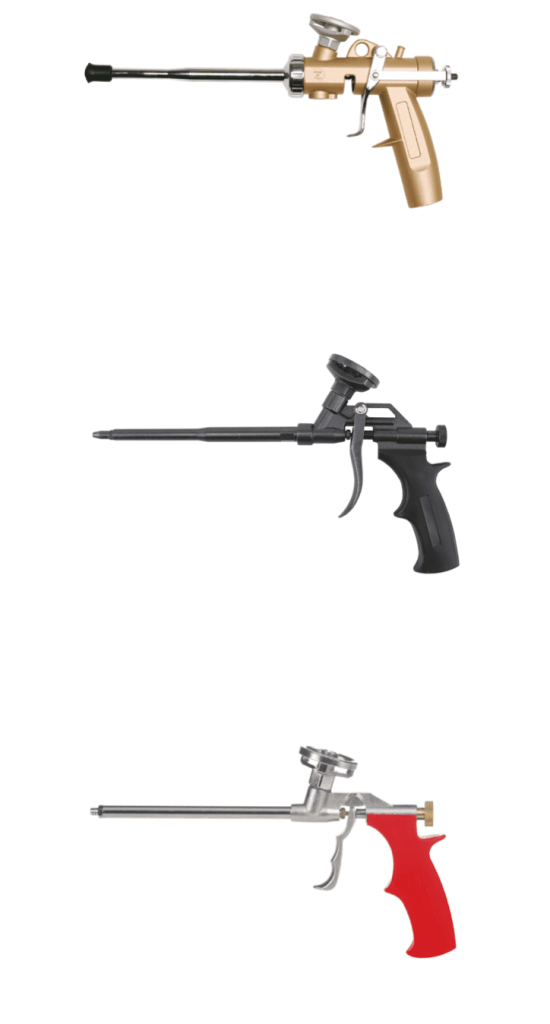
Advantages of the handheld type:
- Handheld Polyurethane foam does not require additional cost for purchasing a foam gun.
- Simple and easy to apply.
Disadvantages of the handheld type:
- Difficult to measure accurately.
- Needs to be cleaned inside after each use to prevent clogging of the pump nozzle with hardened material.
- May leak after use.
Advantages of the foam gun type:
- Easy to measure, easy to apply.
- Does not leak after use.
- Reusable.
- Less wastage.
Disadvantages of the foam gun type:
- Requires additional cost for purchasing the foam gun and cleaning solution.
Polyurethane foam one-component and two-component versions
One-component PU foam consists of polyol and isocyanate mixed in a single container with the addition of a propellant, which cures through reaction with moisture in the atmosphere and the substrate. The reaction results in cross-linking and expansion.
Two-component PU foam, also known as 1 1/2, comprises three parts: Polyol, isocyanate, and a propellant. The fourth component (curing agent or catalyst) is added before foam formation. The 1 1/2 component foam cures very quickly without requiring atmospheric moisture, as the fourth component replaces the air’s moisture. This leads to faster curing with limited expansion. However, it has a short usage time, reducing to a few minutes after activation.
Two-component PU foam is suitable for:
Filling deep voids or large gaps in a single application.
Areas with insufficient air or surface moisture.
Installing window frames, doors up to 40kg.
Expansion capability.
Filling capability of PU foam
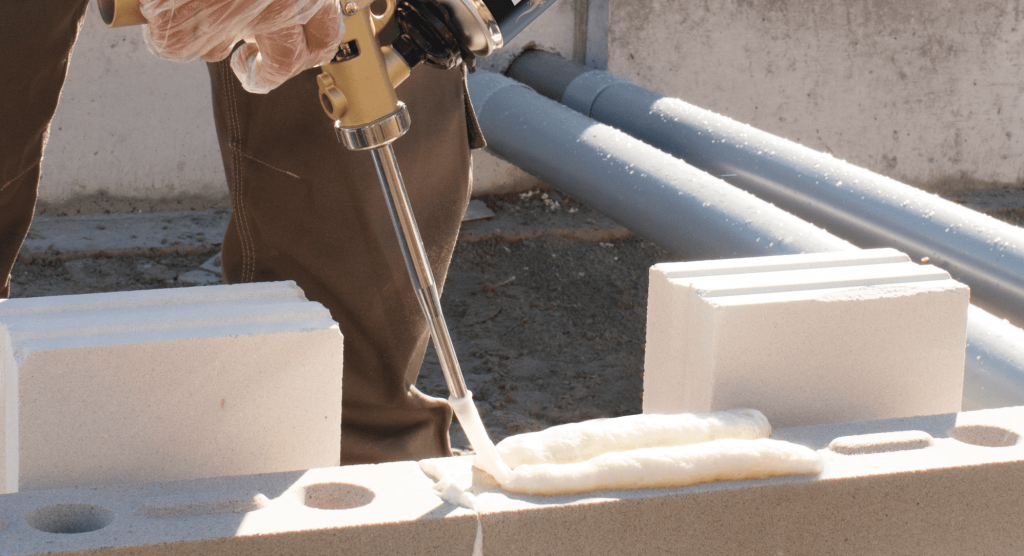
The polyurethane foam adhesive can be utilized to fill cracks and gaps within the structure of buildings. Examples include spaces between walls, frames, and doorways. For these applications, Bostik offers both standard and premium-grade foam. Filling cracks or gaps should not exceed 50 to 70%. The foam will begin expanding immediately after use.
Adhesive Properties
Bostik manufactures various premium-grade PU foam adhesives, both one and two-component, based on polyurethane to bond different materials. Environmentally friendly, time-saving, clean application, low cost, and simple deployment are the main advantages.
Sealing Capability
The air-tight nature helps eliminate unwanted airflows. Bostik provides unique foam types with very high thermal insulation values and very low air permeability, surpassing conventional standards.
Heat Resistance & Fire Retardance
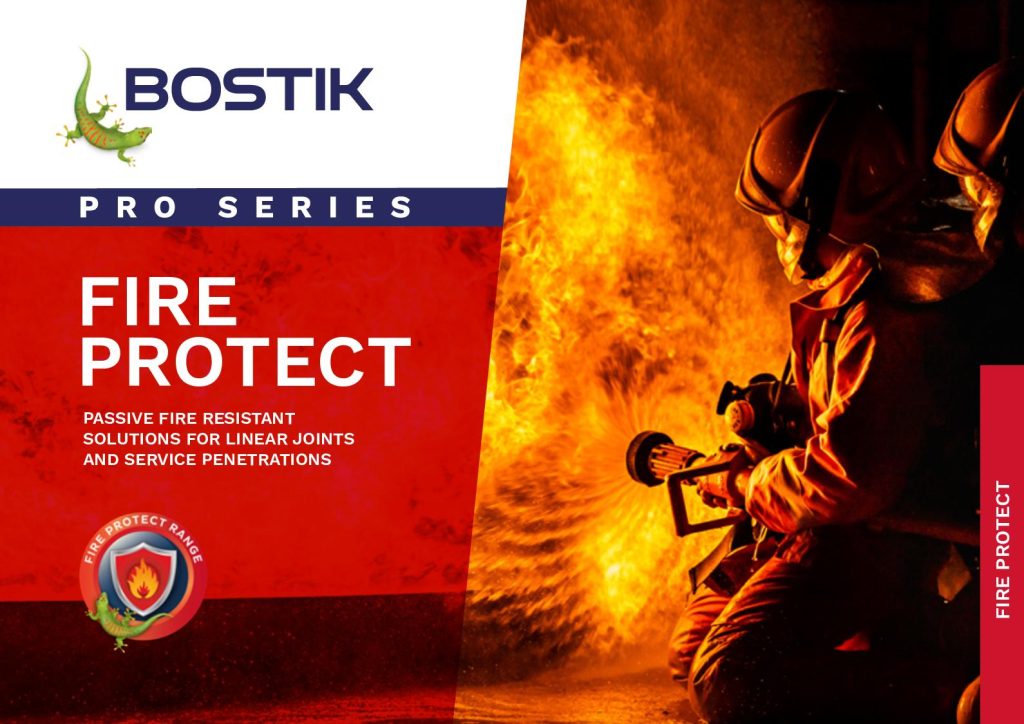
Polyurethane foam adhesives are used for a variety of applications, including filling cracks and gaps in building structures. They are versatile and can be applied as a thermal insulation barrier to surfaces, preventing the passage of smoke, heat, and fire. This improves the fire resistance of buildings, allowing people to evacuate to a “safe” environment and enabling emergency services to carry out their tasks.
Special Types of Foam:
- All-Season Foam: Suitable for use within a wide temperature range (+10°C to +35°C).
- Winter Foam: Can be used even in freezing temperatures (-10°C to 25°C).
- Mega or Maxi Foam: High productivity, yielding from 50L to 65L per can.
- Flame Retardant Foam: B2 or B1 rated foam designed to resist combustion.
- Flexible Foam: A single-component polyurethane foam that remains flexible after curing, ideal for applications with repeated movement or requiring vibration resistance, such as doors, windows, and pipelines.
- Bonding Foam: A single-component foam with low density, offering superior bonding and sealing qualities. It adheres well to most building materials, except for “Teflon,” polyethylene, and silicone surfaces. Its primary application is for installing insulation boards (EPS and XPS), roof tiles, pipes, and various cement, concrete, and stone materials.
Guidelines for Using Polyurethane Foam Adhesive:
General application guidelines for polyurethane foam using a foam gun:
- Read the technical data sheet of the polyurethane foam adhesive to determine the recommended application temperature and pressure. This may vary for each product.
- Hold the can with the valve facing upwards and attach the foam gun with a threaded NBS nozzle to the can. It is recommended to use an NBS Gold nozzle (refer to the instructions inside the foam gun box).
- Shake the can vigorously before use at least 30 times. Turn the can upside down and apply the foam. To adjust the foam flow rate, loosen the valve at the back of the handle. Fill half of the gap, and in case of low humidity, lightly spray water on the foam. The foam will expand to fill the remaining portion.
- Protect your eyes, wear gloves, and safety gear. Cover the floor and furniture with paper or plastic sheets. Wider and deeper gaps exceeding 4cm should be filled in multiple layers.
- Wait 15-30 minutes between applications. Lightly spray water before each application. Only use in well-ventilated areas.
- Store the can upright between +5°C and +25°C. Note: Pressurized container! Protect from sunlight and do not expose to temperatures exceeding +50°C. Do not pierce or burn, even after use.
- Contains flammable propellant. Do not spray into an open flame or any hot, glowing material. Keep away from ignition sources. Do not smoke. Once you have finished your work, close the valve at the back of the handle and store the foam gun upright.
General guidelines for using handheld PU foam
- Read the technical data sheet of the polyurethane foam for the recommended application temperature and pressure. This may vary for each product.
- Remove the cap and securely attach the nozzle to the valve.
- Shake the canister vigorously before use, at least 20 times.
- To activate the foam, turn the canister upside down and press the trigger. Fill half of the gap, and in case of low humidity, lightly spray foam with water. The foam will expand to fill the remaining space.
- Protect your eyes, wear gloves, and appropriate protective gear.
- Cover the floor and furniture with paper or plastic sheets.
- For gaps wider and deeper than 4cm, apply multiple layers. Wait 15-30 minutes between applications. Before each application, lightly moisten the foam with water.
- Use only in well-ventilated areas.
- Store the canister upright at temperatures ranging from +5°C to +25°C. Pressurized container! Protect from sunlight and do not expose to temperatures exceeding +50°C. Do not drill or burn, even after use.
- Contains flammable propellant. Do not spray towards an open flame or any hot, glowing material. Keep away from ignition sources. Do not smoke.
- Once finished, close the valve at the back of the handle and store the foam gun vertically.

Fill half of the gap, and in case of low humidity, lightly spray foam with water.
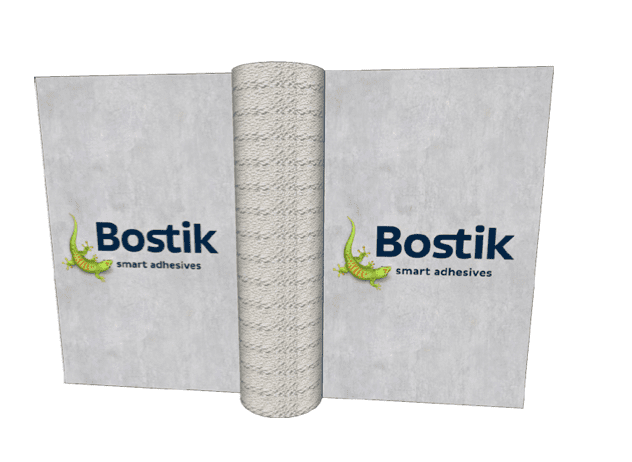
The foam will expand to fill the remaining part.

When the polyurethane foam has expanded and exceeded the cut-off time (which can be found on each polyurethane foam technical datasheet), the excess polyurethane foam can be cut.
Storage
Luôn cất hộp thẳng đứng, điều này sẽ tránh được van bị dính.

Always store the box upright to prevent the valve from sticking.
Store the boxes in a shaded environment at temperatures ranging from +5°C to +25°C. Higher temperatures during storage may reduce the shelf life. If the box is nearing its expiration date, shake it more vigorously. Polyurethane is sensitive to temperature during storage, so shake more vigorously at lower temperatures. If the valve does not open after storage lying flat, do not force it open! Always handle the box and canister carefully, using both hands to carry the box.
Safety first
Polyurethane is highly versatile, but for health and safety reasons, use materials with the lowest possible free isocyanate content. Always protect your eyes and wear gloves and work clothes.
Installing interior door frames with PU foam
Repairing indoor doors with 2-component foam:
Installing interior door frames can be bonded using polyurethane foam following these guidelines:
- Maximum door weight of 40 kg
- Moisten the surface foam at least 30% behind the door.
- Foam width ranges from 8 to 25 mm.
- A minimum of 6 foam bonds per door frame.
- Foam curing time is at least 2 hours from application to removal of the frame clamp.
Note:
- Expansion may occur afterward at low temperatures in applications.
- The box temperature should never exceed 25°C.
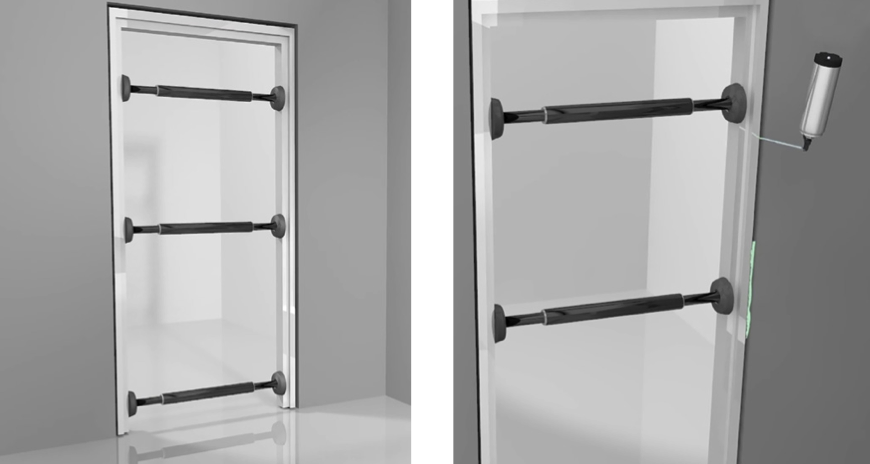
Here are the instructions:
- First and foremost, before starting the door installation, check the manufacturer’s instructions for the door.
- Use shims and wedges to temporarily secure and adjust.
- Use a specialized frame spreader with integrated clamps to prevent frame distortion.
- The shims must be positioned at the height of both the hinge and the lock.
- Measure the width inside the door frame at the top, middle, and bottom. The distances should be equal everywhere. Check both top corners, they must be square.
- Before applying PU Foam, the door must be flattened and checked to see if it opens and closes correctly.
- The door frame and sill must be protected with paper or tape to avoid getting dirty.
- It is advisable to spray 2-component foam into the joint between the wall and the door frame at locations with shims on both sides, usually spraying a total of 6 points.
- Once the 2-component foam has completely cured, the gap between the door frame and the wall will be filled with 1C PU Foam.
- DO NOT remove the shims at this stage or add shims as described in the 1-component PU Foam installation process.
- Do not remove the shims before the foam has fully cured, wait at least 3 hours, depending on the surrounding environmental conditions. In rooms with very dry air, it may take up to 24 hours.
Installing an external thermal insulation facade system on buildings using PU foam
- Keep the box with the valve facing upwards and attach the foam gun with NBS-threaded nozzle onto the box. We recommend using NBS Gold (refer to instructions inside the foam gun box).
- Shake the box vigorously before use at least 30 times.
- To adjust the foam flow, loosen the valve at the rear of the gun handle. Protect your eyes and wear gloves and work clothes.
- To apply the foam adhesive, invert the box and press the trigger.
- Apply adhesive to the insulation panels, along the edges, 5 cm from the edge, and inside the edges, forming continuous lines with a spacing of 30 cm between the lines.
- The recommended diameter of the foam bead to be used with the gun is 10-12 mm.
- Tighten the polystyrene panels in their final positions for about 6-10 minutes, before the adhesive begins to harden. Any irregularities can be corrected within a maximum bonding range of 10 minutes, depending on temperature and humidity.
- Insulation panels at the base of the wall should be supported from below to prevent them from sliding off the wall until the adhesive sets and the panels are securely attached (5-24 hours).
- Fill any gaps between the insulation panels with foam adhesive to achieve an effective and continuous insulation layer.
- Store the box upright at temperatures ranging from +5°C to +25°C.
- Pressure vessel! Protect from sunlight and avoid exposure to temperatures exceeding +50°C. Do not penetrate or burn, even after use.
- Contains flammable propellant. Do not spray into an open flame or any hot, glowing materials. Keep away from ignition sources. Do not smoke.
- After completing the task, close the valve at the rear of the gun handle and store the foam gun in an upright position.
Contact information
Please contact Hitta to get detailed advice on standard-compliant PU foam adhesive solutions that align with your business processes, helping optimize costs and significantly increase efficiency.
- ☎️ Hotline: 0565.336.879.
- ✉️ Email: hittajsc@hitta.vn

